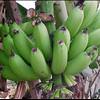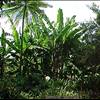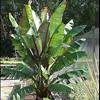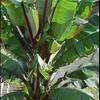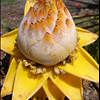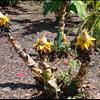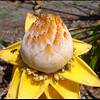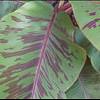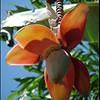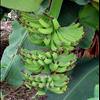This plant may be available to buy
Click the banana to see

|
click pic to enlarge |
|
Zone 9-10 and indoors Bananas are terrific tropicals and major cool indoor plants almost anywhere. Most folks want eating bananas Bananas are very easy to grow. For that "air of the tropics" nothing exceeds the look of a banana tree or a fine fruit patch of bananas click pic to enlarge In the tropical reference TROPICA by Alfred Byrd Graf, when you look up banana, it says, "See Ensete" which are non-fruiting types. This Ensete maurelii hits 40 feet tall click pics to enlarge The banana family is Musaceae, and is related to the heliconias and travelers palm. Banana is really not a "tree" but a herbaceous perennial. Most are full sun plants for best fruit production, but some shade is fine, especially for ornamental varieties (no fruit, but flowers), indoors Ornamental, Musella lasiocarpa,click pics to enlarge There are many varieties from dwarf types to some over 30 feet in height Plantains look and grow just like bananas. There are types that are a cross between banana and plantain. Some you cook, some you don't. There are also ornamental bananas. Some have colorful leaves as this one below click pic to enlarge You can not over feed nor can you over water your banana plants, although good drainage is required Bring in as much organic matter as possible for your planting site. Ideally, your rich soil (not heavy muck-like soils) would be over one foot deep with two feet being even better. Creating a raised area of this soil is nice and will help with drainage. A mix of 50-50 very coarse sand and very rich soil is good combination. Create a large area, say 10X15 feet, if you have the land available Pick a protected location so the wind doesn't tear up your banana leaves although the wind is not likely to harm your plant or fruit production. You and the plants will be much happier in a protected area. Provide maximum sun Plant your banana in the rich soil, water and enjoy. Nothing will happen for a while because the first growth will occur under ground. After the banana has set its underground corm to its satisfaction, your tree will start to grow As the first stem starts to grow, another stem will appear close to the first stem. Then another, and another ...forever For best management (especially for fruit) never allow more than three stems ...one large, one medium and one baby stem. Use a sharp knife to cut off all other stems. Cut somewhat below the soil line. You will have to cut off unneeded stems regularly Cutting stems pushes food to the main three stems which you hope will fruit. If you allow more stems, you end up with too much foliage and not enough food for fruiting. Even if you feed super heavily, you will end up with a very congested mass of stems and not much more fruit Critical to quality >>> Use a high potassium fertilizer when you feed. Buy a formulation similar to 5-10-10 or 10-20-30. Plan on 40-50 .lbs for the year spread out evenly during all the early spring through mid fall months You have been told that bananas are great for your health because of their potassium content, which is true, so feed them potassium. Keep the nitrogen content low-ish. Feed organically if you can but use chemical fertilizers as well for maximum production Water often and water deeply. Again, make sure there is good drainage too. Never let your bananas sit in a pool of water Mulch your bananas thickly...say about 2-3 inches of mulch (for added moisture retention / not cold protection) As the plant grows, the older leaves will yellow as new leaves appear. You can elect to do nothing and the yellow leaves will shrivel and become re-absorbed into the plant. If you do not like the appearance of yellow leaves, use a sharp knife to cut them off. We like to throw the cut leaves on top of the much to add even more mulch and return the nutrients back to the soil and plants Best = do nothing About a year after planting, your banana will form a flower click pics to enlarge Banana flowers can be huge. They hang down pointing at the ground. The flower has flaps that will open upward in series over many weeks. As each flap opens, you will see cup-like flowers. Pick one and drink the liquid. You won't believe how wonderful the nectar tastes. The bees will be around to get their share as well as many other insects Your banana will eventually start forming "hands" of fruit (just like you see in your grocery store) click pic to enlarge The fingers will be small at first. As the fruit matures, the fingers get fatter, but stay green. As the hands get longer and fatter, the flower keeps opening. At some point, no more hands form. You can cut off the flowering stem below where no more hands are forming The size of your fruits will be substantially determined by the variety of your banana. However, the size and number of fruits are determined over the course of a full year of growth. If you fed and watered well (right from the beginning), you may get close to 100 eatable bananas at harvest time. If you skimped, you may get 20-25 fruits. Feed well for best appearance, maximum fruit numbers and taste and quality Home grown bananas are excellent for flavor. Home grown bananas far exceed grocery store varieties for taste. There is a freshness and a sweetness and a tang unmatched by grocery store fruit As your banana fingers get fatter and fatter, at some point they stop getting bigger. Observe your fruit often to notice this growth and the stoppage of growth. About 4-6 weeks after finger growth has stopped, cut off the whole stalk of bananas. Make your cut very close to the main banana stalk or right through the top of the banana plant. If you do this right, you will get a large "hook" at the top of the stalk and all the hands hanging below. Hang the whole stalk in a shady spot outside and at about chest level It will still be weeks before your bananas ripen. When they ripen, they usually ripen top-to-bottom. Pick off ripe fruit and eat it. Don't let the fruit over-ripen as it will split then rot. Also, you don't want to attract animals to your fruit. Hang the bunch low and let your children eat them any time they pass by Your last job is to cut off the whole "mother" stem from which you got your bananas. It will never again give you fruit. If you do nothing, it will just rot and die. Cut if off (with a large knife) and put the parts into your composter or on the soil at your banana patch for more mulch Now your medium stalk will be next to bear fruit If you have plenty of banana flowers, click pic to enlarge you can eat them too (flowers are seen for sale in South Florida markets) Cut the flower in half the long way. Salt with coarse salt for 3-4 hours, rinse off the salt, slice thinly for your salad ...can also be grilled Want to give a banana to a friend? Get a sharp straight shovel. Use the shovel to cut down into the soil between the largest stem (the smaller one is closest to). Cut down deep. We like to wait a week or two at this point. After a week or two, finish cutting out the baby banana. Wrap the bottom of the baby and its roots in several layers of wet newspapers. Take your gift to your friend. Plant as soon as possible. Waiting more than a day or two may kill the baby plant Indoor Banana Culture First, note all the facts (above) for outdoor growth, i.e. light, water, soil, drainage and fertilizer. Come as close as you can to these conditions and care My oldest memory of a banana tree was in 5th grade where our teacher, Mr. Shaw, had a banana plant in our home room class in Michigan Indoors, your banana will be very attractive, but fruit is not likely unless you have a hothouse You will want to wash your stem and leaves from time to time to keep them dust free, which usually keeps the bugs away (like mites). Use a mild dish soap with water and a sponge. Be sure to clean the bottom sides of the leaves Provide maximum sun/light/hours and warmt, a Gro Light will be very helpful Try to tolerate spent leaves (versus cutting them off) as they turn from green to yellow to brown then shrivel (normal cycle). This allows your plant to re-absorb the leaf nutrients and makes for a nicer looking more natural older plan If you do these simple maintenance rounds, you will have a very fine indoor banana plant
Below are over 100
|
